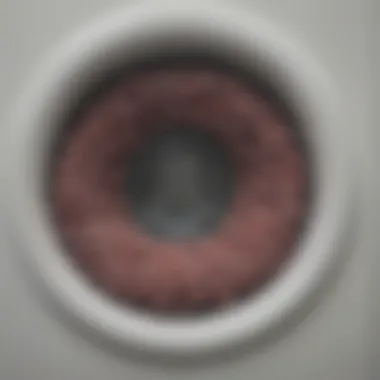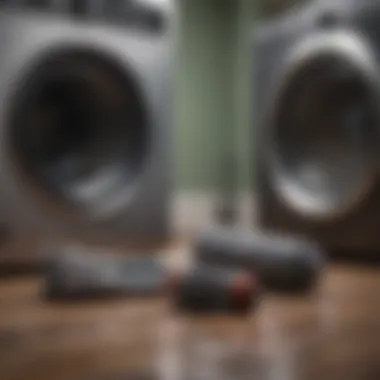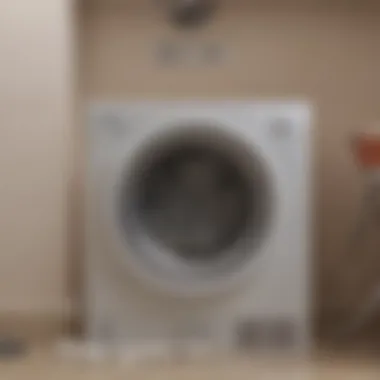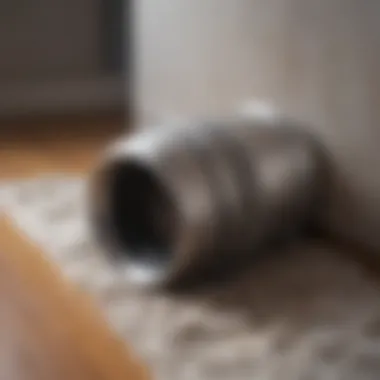Expert Tips for Cleaning Lint from Dryer Vents


Intro
Cleaning the lint from your dryer vent is often underestimated by many homeowners. This task may seem trivial, yet it holds significant importance for your home's safety and appliance efficiency. Lint buildup can pose a fire hazard and diminish the dryer’s performance, leading to higher energy costs. Understanding how to clean your dryer vent effectively is essential for maintaining an optimal operating environment. This guide aims to demystify the process, providing you with a nuanced understanding of the methodologies and tools available for this important task.
Key Insights and Trends
While the focus here remains on dryer vent maintenance, a growing awareness has emerged regarding household safety practices. Homeowners increasingly recognize the direct link between appliance care and home safety.
Additionally, the overall trend in sustainable living has led many to seek ways to optimize household appliances, including their dryers. A cleaner vent not only ensures effective drying but also supports energy efficiency, reducing the home's carbon footprint.
Importance of Cleaning Dryer Vents
Many people might wonder why dryer vent cleaning is even necessary. The truth is that lint can accumulate rapidly within a dryer vent. Lint traps only catch a portion of this debris, allowing the remainder to escape into the venting system. Regular maintenance is required for optimal performance.
Moreover, the risk of fires cannot be overlooked. According to the U.S. Fire Administration, an estimated 2,900 home dryer fires occur each year, causing five deaths and over 100 injuries. Most of these incidents arise from failure to clean the dryer vent.
"Regular dryer vent maintenance is crucial, not just for efficiency but also for safety."
Signs You Need to Clean Your Vent
- Longer drying times. If clothes are still damp after a complete cycle, this indicates obstruction in the vent.
- Burning smell. If you detect an unusual odor, it could be lint overheating.
- Your dryer is hotter than usual. Excessive heat during operation can signal an issue with airflow.
- Lint buildup visible outside the vent. If you can see lint again, it’s time to act.
Properly addressing these signs can prevent potential hazards and ensure that your dryer operates efficiently. Regular checks should form part of your home maintenance schedule.
Practical Tips on Cleaning Your Dryer Vent
A thorough cleaning requires some specific tools and techniques. Here are steps to follow for efficient vent cleaning:
Basic Cleaning Method
- Unplug the dryer. Your safety is paramount. Always start by disconnecting your dryer from the power source.
- Remove the vent hose. Unscrew the clamp securing the vent hose to the dryer.
- Clean the vent hose. Using a vacuum attachment, carefully remove lint from the hose. If it is significantly clogged, washing it with warm water might also help.
- Use a dryer vent brush. A vent brush can efficiently clean deeper into the vent system, reaching areas the vacuum might miss.
- Reassemble and test. Put the vent hose back in place and reconnect the dryer. Run a test cycle to ensure proper airflow.
Advanced Cleaning Techniques
For those more comfortable with tools, consider these advanced cleaning methods:
- Professional tools. Investing in a dryer vent cleaning kit can simplify the process. These kits contain flexible rods and brushes that allow you to reach deep into the venting system.
- Invasive cleaning. In some cases, particularly if there is extensive lint buildup, hiring a professional service might be prudent. Technicians have specialized equipment designed for thorough cleaning.
By committing to regular cleaning of your dryer vent, you significantly enhance both safety and efficiency. You contribute to mitigating fire risks and improving the longevity of your appliances.
Understanding Lint Buildup
Lint buildup in dryer vents is a significant concern for homeowners. Understanding this phenomenon is essential for maintaining safety and the efficiency of your dryer. When lint accumulates in the vent system, it can lead to several issues, including reduced drying efficiency and increased risk of fire hazards. Knowing what lint is, how it collects, and the common causes of its accumulation can help you take the necessary preventive steps to keep your dryer functioning properly.
What is Lint?
Lint primarily consists of small fibers shed from clothing and fabrics during the drying process. These fibers are the result of wear and tear on materials, particularly those made of cotton, wool, and synthetic blends. Each time clothes tumble in the dryer, a certain amount of these fibers is released into the air and collected in the dryer’s lint trap. However, not all lint is captured, and some escapes into the venting system.
How Lint Accumulates in Dryer Vents
Lint accumulates in dryer vents as a result of several factors. Firstly, when clothes are dried, moisture is removed, and the fibers released can gather within the vent ducts. If the vent is not cleaned regularly, this accumulation increases over time. Furthermore, if the dryer is not vented properly—such as using improper duct sizes or types—lint can become trapped. Poor airflow caused by kinks, bends, or blockages within the venting system exacerbates this issue.


Common Causes of Lint Accumulation
There are several common reasons for lint buildup in dryer vents:
- Infrequent Cleaning: Regular maintenance is crucial to removing lint. Neglected lint traps and ducts can lead to severe buildup.
- Clogged Vents: If the venting system is blocked with lint, moisture cannot escape, resulting in lint accumulation.
- Improper Installation: Incorrectly installed vent systems do not allow for proper airflow. This can cause lint to settle and accumulate.
- High Lint-Producing Fabrics: Some materials produce more lint than others, increasing the risk for buildup. Fabrics like towels or blankets tend to shed more fibers.
Regular maintenance of your dryer vents is not just a recommendation; it is a necessity for safety and efficiency.
By understanding lint buildup, homeowners can take proactive steps to mitigate risks associated with clogged dryer vents, extending the lifespan of their appliance while enhancing safety.
Risks Associated with Clogged Dryer Vents
Understanding the risks associated with clogged dryer vents is crucial. Neglecting this aspect can lead to severe consequences, not just for your appliance but also for your home and safety. You may think that a simple lint trap cleaning suffices, but this is only part of the process. Clogs can escalate rapidly, resulting in fire hazards, increased energy costs, and appliance damage.
Fire Hazards
The focal point of concern with clogged dryer vents is fire hazards. According to the National Fire Protection Association, nearly 17,000 home fires are attributed to dryer problems annually. The primary reason being lint accumulation. Lint is highly flammable and when it builds up in the vent, it restricts airflow. This can cause the dryer to overheat, igniting the lint and potentially leading to devastating house fires.
Homeowners must recognize the importance of regular maintenance. Regularly checking and cleaning the dryer vent can be lifesaving. Ensure that the vent is free of lint and that the external vent hood opens properly when the dryer is in use.
Increased Energy Costs
Another significant but often overlooked aspect of clogged dryer vents is the increased energy costs. When lint obstructs the airflow, the dryer works harder to dry clothes. This puts unnecessary strain on your appliance, using more energy than required. Consequently, you may notice a noticeable spike in your electricity bills.
Consider this: when a dryer operates efficiently, it should take approximately 30 to 45 minutes to dry a load. If you experience drying times longer than this, it may point towards a blockage in the vent. Investing time in cleaning the vent is not only crucial for safety but also financially prudent.
Appliance Damage and Reduced Lifespan
Clogged vents lead to appliance damage, which in turn reduces the lifespan of your dryer. A dryer that operates under stress due to blocked airflow can suffer from several issues, including overheating and overheating-related malfunctions. The longer you ignore these signs, the more likely you will experience breakdowns.
Maintaining your dryer vent impacts its longevity. You can save on repairs or replacement costs simply by ensuring that your dryer can function as intended without unnecessary strain.
"A clean dryer vent is not just about safety; it’s about saving money and ensuring appliance efficiency."
Signs of a Clogged Dryer Vent
Identifying the signs of a clogged dryer vent is critical for maintaining a safe and efficient drying process. Homeowners need to be aware of these indicators, as they serve as early warnings for potential challenges that may arise from neglecting the cleanliness of dryer vents. Recognizing these signs can facilitate timely action and prevent serious issues down the line.
Longer Drying Times
One of the most common signs of a clogged dryer vent is longer drying times. If clothes are consistently taking more than one cycle to dry, this could indicate that the vent is blocked or restricted. The dryer has to work harder to push hot air through the lint buildup, which slows down the drying process. This inefficiency not only increases energy consumption but also places unnecessary stress on the appliance. Homeowners should take note if they find themselves repeatedly running multiple cycles just to achieve dry laundry.
Frequent Overheating of the Dryer
If your dryer frequently overheats, it is another sign of a potential blockage in the vent. An overheating dryer may cause clothes to become extremely hot to touch or even emit a burning smell. This occurs because the hot air generated during the drying cycle cannot escape properly due to lint accumulation. Over time, this overheating can lead to serious safety hazards, including appliance damage or increased risk of fire. Monitoring the temperature of your dryer is essential to catch this issue early on.
Increased Amount of Lint in the Lint Trap
An increased amount of lint in the lint trap is a straightforward indicator of a clogged dryer vent. If you find yourself cleaning the lint trap after every load and it's still filled to the brim with lint, then the vent may not be expelling air as it should. The lint trap's primary function is to catch lint and debris from your clothes. If the vent is blocked, the airflow is restricted, causing more lint to accumulate in the trap instead of being expelled outside. This not only signals clogging but also limits the dryer’s effectiveness. Regular checks of the lint trap should help homeowners ensure optimal airflow and dryer functionality.
Cleaning Tools and Materials Needed
In the context of dryer vent maintenance, having the proper cleaning tools and materials is crucial. Efficient cleaning not only ensures that lint does not accumulate but also helps in maintaining the effectiveness of your dryer. A clean vent allows for better airflow, which can significantly enhance drying performance and reduce energy consumption. Inadequate cleaning tools can lead to ineffective results and may even cause damage to the vent system or the dryer itself. Understanding what tools you need and how to use them effectively can streamline the cleaning process while ensuring safety.


Essential Tools for Basic Cleaning
Basic cleaning of the dryer vent does not require highly specialized equipment. However, certain essential tools play a significant role in removing lint and debris effectively:
- Lint Brush: A lint brush is an invaluable tool for regular cleaning. It can reach into the lint trap and help dislodge lint that may have settled deeper within.
- Vacuum Cleaner with a Hose Attachment: Using a vacuum cleaner with a hose lets you suction out lint and debris effectively. A shop vacuum works well because of its ability to handle larger clumps of lint.
- Screwdriver set: Certain vent configurations may require you to unscrew parts of the vent system. A basic screwdriver set will enable you to open access points safely.
- Cloth or Microfiber Towel: A clean cloth can help in wiping down areas around the dryer and vent exit, ensuring no residual lint is left behind.
These tools are easy to find and can typically be found around the home or purchased at a local hardware store. They form the foundation of any effective dryer vent cleaning routine.
Advanced Equipment for Deep Cleaning
For those who wish to go beyond basic maintenance, more advanced equipment can provide a deeper clean. If you are dealing with extensive lint build-up or hard-to-reach areas, consider the following:
- Lint Removal Kit: These kits typically include a flexible, long-reaching brush that can navigate straight and curved ducts effectively. They generally come with multiple brush heads to suit different sizes of vents.
- Duct Cleaning Vacuum: If available, a duct cleaning vacuum integrates specialized attachments that can clean out dryer vents and ducts thoroughly. They have the suction power needed to remove stubborn lint buildup.
- Inspection Camera: An inspection camera allows you to look deep inside the vent. This equipment can help identify blockages and areas requiring focused cleaning efforts.
- Air Compressor: An air compressor can blow out any remaining lint stuck in tight places. Make sure to use this tool cautiously to avoid dislodging debris into the home environment.
Utilizing advanced equipment may require additional effort and investment but proves to be beneficial for long-term dryer performance and safety. Regular use of these tools can prevent major issues from developing, ultimately extending the lifespan of your dryer and ensuring that it operates remained as efficiently as possible.
Step-by-Step Guide to Cleaning Your Dryer Vent
Cleaning the dryer vent is crucial for maintaining efficient operation and safety in your home. This guide provides a structured approach to ensure that you remove lint effectively and prevent potential hazards. By following these steps, you can contribute to the performance and longevity of your dryer while mitigating risks associated with lint accumulation.
Preparing the Dryer for Cleaning
Before you start the cleaning process, you should prepare your dryer properly. First, check the area around your dryer for any obstacles that could hinder your progress while cleaning. Clear any items or clutter from the top and sides of the appliance. This ensures you have enough space to work and access all parts of the dryer.
Next, gather all your necessary tools and materials. Having everything you need at hand will make the process smooth. Essential items include a vacuum cleaner with a long hose attachment, a lint brush, and possibly a screwdriver for accessing the vent more easily. Moreover, put on gloves to protect your hands from dust and debris during the process.
Disconnecting the Dryer from Power Source
Safety is paramount when cleaning a dryer vent. Begin this step by unplugging the dryer from the wall outlet. If your dryer uses gas, turn off the gas supply as well. This step is important to prevent any accidental starting of the appliance while you are cleaning. Make sure the dryer is completely disconnected before moving on to accessing the vent.
In addition, ensure that the space is well-ventilated. This will help to manage any dust or lint particles that may enter the air during the cleaning process.
Accessing the Dryer Vent
Once the dryer is disconnected, the next step involves accessing the dryer vent. This vent usually runs from the back of the dryer to an exterior vent on your house. First, gently pull the dryer away from the wall to expose the vent. Be cautious not to damage the hose or connections.
Next, unscrew the duct from the back of the dryer. Depending on your model, this may require a simple twist or the use of a screwdriver. If your dryer vent is flexible, it may be easier to detach it. Take care when handling the vent, as accumulated lint can fall off.
Using a Brush or Vacuum for Lint Removal
After accessing the vent, begin the cleaning process. If using a vacuum, stick the hose into the vent to capture any loose lint. Move the hose back and forth to ensure thorough removal. For more thorough cleaning, a brush specifically made for cleaning dryer vents can be immensely helpful. Insert it gently into the vent and push it in, then pull it back out, repeating as necessary.
Make sure to pay special attention to bends or turns in the duct where lint tends to accumulate. This step is vital to ensure that airflow is not restricted, which can lead to inefficient drying and increased fire risk.
Reconnecting and Testing the Dryer
After you finish cleaning the vent, reconnect the duct to the back of the dryer securely. This ensures no leaks will happen when the dryer is operational. Once this is done, place the dryer back in its original position and plug it back into the power supply or reconnect the gas line.
Finally, conduct a test run of the dryer on a low setting for a few minutes. You should observe if the air is flowing freely from the outside vent. A clear, robust airflow signifies that the cleaning was successful and that your dryer is working as it should. If the air feels restricted, you may need to repeat some earlier steps for a more thorough clean.
By following this step-by-step guide, homeowners can ensure that their dryer vents are maintained effectively, enhancing safety and performance. Regular maintenance also supports the longevity of the dryer, making it an essential home task.


Maintaining Your Dryer Vent Post-Cleaning
After cleaning your dryer vent, maintenance becomes critical. Frequent lint buildup can occur again, negating your previous efforts. Keeping your vent clear enhances the efficiency and safety of your dryer. It is essential to establish a routine, so you don't get into a situation where cleaning is needed less frequently. You can prevent problems with fire hazards and appliance damage by making maintenance a priority.
Establishing a Cleaning Schedule
Creating a cleaning schedule is an effective strategy to keep your dryer vent in optimal condition. Depending on how often you use the dryer, you should consider a range of intervals for cleaning. For example, if you use your dryer daily, a schedule of every three months is advisable. On the contrary, if your dryer is used less frequently, cleaning every six months may be sufficient.
Factors to consider include:
- Type of dryer
- Amount of laundry you do
- Presence of pets or heavy fabrics (like blankets) that may generate additional lint
Having a clear schedule will help in tracking when cleaning last occurred, ensuring that you can plan for the next session. Sticking to this routine can help keep your vent clean, maintain airflow, and reduce the risks associated with lint buildup.
Monitoring Performance Indicators
Recognizing performance indicators can signal when it may be necessary to clean your dryer vent before the next scheduled cleaning. Some common indicators include:
- Longer drying times: If clothes consistently take longer to dry, lint may be obstructing airflow.
- Increased lint accumulation in the lint trap: Excess lint may indicate that there is a blockage in the vent.
- Overheated dryer: If your dryer feels hot to the touch or you notice a burning smell, it's a sign of lint blockage that can be dangerous.
- Dryer shuts off frequently: This may be due to an automatic safety feature kicking in because of overheating.
By keeping an eye on these signs, you can proactively maintain your dryer vent's condition. The goal is to ensure continual optimal performance, safety, and energy efficiency in your home.
"Preventive maintenance is the key to keeping your dryer functioning well over the long term."
In summary, maintaining your dryer vent post-cleaning is essential. A clear cleaning schedule and vigilant monitoring of performance indicators can significantly extend the lifespan of your appliance while ensuring a safe environment in your home.
When to Seek Professional Help
Cleaning your dryer vent is crucial for maintaining efficient dryer performance and minimizing safety hazards. However, there are instances when it is wiser to seek professional assistance. Understanding when to turn to an expert can save you time, effort, and potential problems down the line.
Identifying Complex Clogs
Not all clogs are the same. Some can be easily cleared with basic tools, while others may pose more significant challenges. Complex clogs can occur due to various factors, including:
- Lengthy Venting Systems: If your dryer vent runs over long distances or contains multiple bends, lint can accumulate more easily. Accessing and cleaning these vents can be labor-intensive and may require specialized equipment.
- External Factors: Trees, bushes, or other buildings can affect airflow, contributing to lint buildup. A thorough inspection may be needed to identify the root cause of recurrent issues.
- Inaccessible Areas: Some dryer vents are difficult to reach, making DIY cleaning ineffective or hazardous.
If you suspect a complex clog, it is sensible to call a professional. They can conduct a comprehensive assessment and use advanced techniques to clear any blockage without risking damage to your dryer or venting.
Choosing an Experienced Technician
Selecting the right professional for dryer vent cleaning is vital. Not all service providers are equal in terms of expertise and reliability. Here are some factors to consider when choosing a technician:
- Certifications: Look for a technician who is certified by recognized organizations, such as the National Fire Protection Association (NFPA) or the Chimney Safety Institute of America. These certifications can indicate a level of training and knowledge in handling dryer vent systems.
- Experience: Ask about the technician's experience specifically with dryer vent cleaning. A technician experienced in a variety of vent types will be better equipped to diagnose and resolve issues.
- Reviews and References: Research online reviews and ask for references from previous clients. This will provide insight into the quality of their work and customer service.
- Safety Protocols: Ensure the technician follows proper safety protocols. They should be insured and should have the appropriate safety gear for the task at hand.
Choosing a skilled technician can ensure that your dryer vent is cleaned thoroughly and safely, preventing future issues. Professional help is worth considering when dealing with complex situations, as it not only enhances your safety but also prolongs the life of your appliance.
Ending
The conclusion of this guide encapsulates the significance of regular maintenance of your dryer vent. Understanding its importance leads to better safety, efficiency, and performance of your drying appliances. In this article, we explored different aspects of lint elimination, from recognizing the risks of ignoring your dryer vent to employing suitable cleaning techniques and tools. The culmination of this information emphasizes that by maintaining a clean dryer vent, you not only enhance your appliance's lifespan but also lower the risk of potential fire hazards.
Recap of Safe Practices
To ensure your dryer operates efficiently and safely, adhering to certain safe practices is crucial. Here are key points to remember:
- Regularly Inspect Your Dryer Vent: Make it a routine to check for lint accumulations and ensure everything is functioning as it should.
- Adhere to Cleaning Schedules: Setting a specific timeframe for cleaning keeps you organized and lessens the likelihood of severe clogs. Aim for at least once a year.
- Use Appropriate Tools: Whether using a simple brush for basic cleaning or investing in advanced equipment, the right tools will help you maintain safety.
- Know When to Seek Help: Recognize your limits when dealing with complex clogs. If problems persist, it is wise to call a professional.
Final Thoughts
"An ounce of prevention is worth a pound of cure." By adopting these safe practices, you are investing in the well-being of your living space and the longevity of your appliances.



